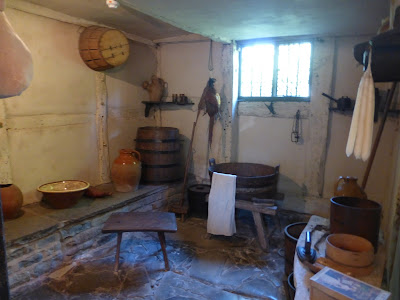Not a great start to the day, as I reversed out of the drive at the same time as the neighbour and we collided. The drives are at right angles with each other and there is a large hedge in between. If I lived here I would definitely get rid of the hedge or cut it right down. Anyway, it was just one of those things and we both agreed it would be a 50:50 claim as neither of us was to blame. Fortunately no-one was hurt and both cars were still driveable.
The circle is known as The King's men
The Whispering Knights
The Kings men stone circle is visible between the Whispering Knights which I'm sure would have been deliberate.

Standing a good distance from the others is The King stone.

It was another beautiful day and we spotted a few Red Admirals flying around. This one kindly posed for me.
The beautiful comma butterfly.
The stones were up on a ridge so we had great views as we were walking around.

The nearest village to the stones was Long Compton where we stopped for a look round its thatched cottages and Norman church..
This is the Lych gate leading to the church. It dates from about 1600 when it was the end of a row of cottages. The word Lych is derived from the Old English for corpse. They were shelters for the party bringing a corpse for burial when it was required that the priest met the corpse at the churchyard entrance. This one has a room above the gate which first became a cobbler's and then an antiques shop in the middle of the last century. Nowadays the room above the gate is loaned to the Compton District History Society.
The gargoyles with piping sticking out of the mouths, to make them more efficient possibly.
The church was closed and cordoned off. The reason was obvious when we went round the other side. was obvious
Apparently it was hit by lightning during a storm in August and until the damage can be repaired it will remain closed.
After lunch in a local pub we moved on to the market town of Northleach, known as a medieval new town.. After the Norman invasion of 1066 many market towns were established. These towns had a simple linear plan, with a long High street lined on both sides by long thin plots of land. These were measured out by using a pole or rod (16 feet long). The plot was 2 poles by 22 poles making an area of a quarter of an acre rented at the cost of a shilling a year. Householders could use the land to grow vegetables and keep chickens and pigs. Early houses had wooden frames and a thatched roof.
The 15th cent church was built by the town's wealthy wool merchants and their amazing brass memorials can still be seen.
This is thought to be the home of one of the wealthiest wool merchants in the town, John Fortey who redesigned the church in the 15th C. It became an inn in the 16th C. It still has the original timbered, jettied upper floor. It is now home to Castle's award winning butcher's shop.
The Old merchants houses now faced with stone
These gabled houses date back to the 17th C
At one end of the town during the 18thC and 19th C was the workhouse (now a care home).
This is the Cotswold Hall founded in 1886 as is still in use as the town community hall.
At the other end of the town from the workhouse was the prison, partially demolished in 1937 it is now the Cotswold Discovery Centre and cafe.


We drove back in the sunshine once again and decided on a last walk around Stow-on-the-Wold before leaving here in the morning.
We found the trees that have grown so close to the fabric of the church door that they look part of it.





















































